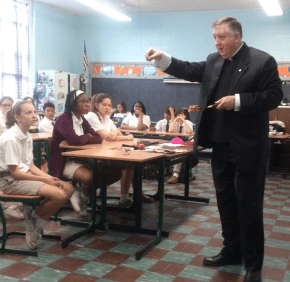By Elizabeth Lowe
elowe@CatholicReview.org
Following a Divine Mercy Sunday liturgy at Holy Rosary in Fells Point April 27, 11-year-old Michael Chorabik asked Baltimore Auxiliary Bishop Mitchell T. Rozanski to teach a religion class at St. Casimir School.
Michael, a sixth-grader at the Canton school, was surprised when the bishop accepted his invitation.
“I thought he would be busy,” said Michael, a parishioner of Holy Rosary.
Bishop Rozanski spent more than an hour at St. Casimir’s parish school May 15.
“I get different invitations,” Bishop Rozanski said, “rarely from students in grade school.”
He accepted Michael’s in part to teach approximately 25 sixth-and eighth-graders about “what a bishop’s role is in the church and that I don’t just show up for confirmations.”
Michael said the bishop’s visit signified “someone is there for them, they can go to a priest or the bishop.”
“It meant that my small school could have someone so big,” he said.
Bishop Rozanski brought items that symbolize his office of bishop, including his miter and crosier.
The crosier “is a symbol for me that I am a shepherd,” he said.
Bishop Rozanski also brought holy chrism, which is a mixture of olive oil and balsam fragrance used to anoint the newly baptized, to seal candidates for confirmation and anoint the hands of priests and the heads of bishops at their ordination.
“When you’re confirmed you’ll have the oil put on your forehead,” he said.
Bishop Rozanski said that at the annual Chrism Mass, celebrated during Holy Week, the archbishop consecrates holy chrism and blesses the oils of catechumens, used at the baptisms of those preparing for the sacrament through the Rite of Christian Initiation, and the oils of the sick, used in the sacrament of the anointing of the sick.
Students asked Bishop Rozanski two dozen questions, including: what life is like as a bishop; how he discerned his vocation to the priesthood; and how the faithful know God hears and answers our prayers.
Bishop Rozanski noted that he oversees 66 parishes in the St. Elizabeth Ann Seton Vicariate, which includes Allegany, Anne Arundel, Carroll, Frederick, Garrett, Howard and Washington counties.
“Since I cover a lot of territory, I spend a lot of my life in the car,” he said. “My days are filled with prayer, meetings and a lot of traveling. Daily Mass and prayer are the most important things for a priest and bishop.”
As a child, Bishop Rozanski said he was attracted to the work of a parish priest.
Discerning his vocation, he said “a bolt of lightning didn’t hit me. It took eight years to become a priest.”
Bishop Rozanski told students that God talks to them, but perhaps not in the way they expect.
“God does speak to us, but God doesn’t speak to us directly,” he said, rather “through the experiences of our lives.”
Sixth-grader Wynnia Harris, who enjoyed Bishop Rozanski’s visit, said learning about how God communicates with the faithful resonated with her.
“God doesn’t just speak to us in the Gospel, but through people we love and care about,” she said.
Dena Stewart, a St. Casimir religion and social studies teacher, liked that Bishop Rozanski brought his crosier and miter.
“It was a physical thing they could touch,” she said. “It’s not in a book or on the Internet.”
“We are thrilled he would take the time to meet with our children,” said Noreen Heffner, principal of St. Casimir. “This was so personal.”
Also see:


